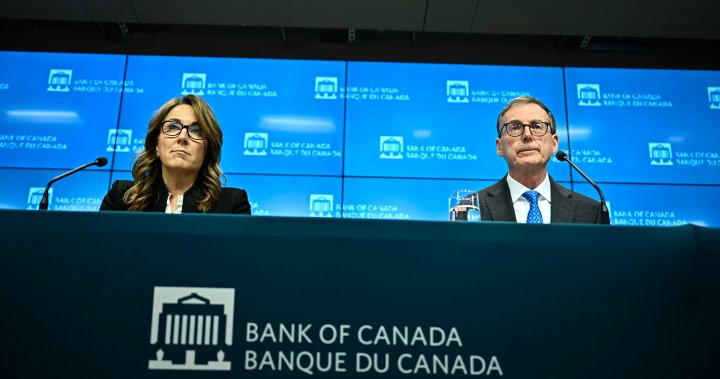Top decision makers at the Bank of Canada had concerns that easing the cost of borrowing could lead to an “overheated housing market” before delivering a cut to the central bank’s policy rate earlier this month, newly released documents show.
The Bank of Canada released a copy of deliberations from its meeting on June 5 where it announced a quarter-point cut to the benchmark interest rate – the first in more than four years and an initial step in the expected easing cycle.
According to those meeting minutes, the Bank of Canada’s governing council weighed the various risks in keeping its policy rate unchanged – maintaining pressure on the economy, the housing market and inflation, by extension – or delivering a cut, as many economists and market watchers expected amid recent signs of easing price pressures.
The latest reading from Statistics Canada shows inflation cooled to 2.7 per cent annually in April. The overall inflation rate has slowed every month so far in 2024, and core inflation, which the Bank of Canada watches closely to gauge its progress, has also shown signs of easing.
In the deliberations, the governing council acknowledged having more “confidence” lately in getting inflation all the way back down to its mandated two per cent target.
‘Overheated’ housing market an inflation risk
But the Bank of Canada also highlighted outstanding risks to the inflation outlook, including fears that a rate cut in June would re-stoke some of those inflationary flames.
Breaking news from Canada and around the world
sent to your email, as it happens.
Cuts to the benchmark interest rate could fuel more activity in the housing market, the governing council noted, which has been cool so far in the typically busy spring season. Pent-up demand from sidelined buyers would have more buying power if borrowing costs dropped, which the central bank said could lead to an “overheated” market.

The Bank of Canada’s latest economic forecasts do anticipate an increase in home prices this year.
Carolyn Rogers, senior deputy governor at the central bank, was asked at the rate decision how the central bank balances the risks of accelerating shelter inflation with its rate cut, but she said that monetary policymakers are not targeting housing activity in particular with the policy rate.
“Ultimately, what we target is inflation,” Rogers said. “We don’t target any particular measure in the housing market or an interest rate, but it’s clear there is some pent-up demand in the housing market. We’ll see how it goes.”
Geopolitical tensions, renewed consumer spending and persistently strong wage growth were also listed as risks to the inflation outlook.
Monetary policymakers also noted that the timing on federal government plans to slow rapid growth in non-permanent residents would have an impact on prices, particularly on rents, going forward.
While newcomers affect both supply and demand in the economy, the Bank of Canada’s governing council said Ottawa’s plans “typically (do) not have a large effect on the inflation forecast.” But shelter inflation is one area where price pressures have remained hot despite the overall cooling in the headline figure, policymakers noted.
The governing council “felt they would need to watch population dynamics carefully in the coming months,” the deliberations read.
The federal government is planning on curbing the share of temporary residents in the country to five per cent of the total population.
According to Statistics Canada, temporary residents represented 6.8 per cent of the population as of April 1.
Fears that U.S. inflation snags would head north
The Bank of Canada’s governing council also had an eye south of the border as it debated the path for its own policy rate.
Despite growing confidence that inflation in Canada was on the right track, policymakers acknowledged risks that progress could stall, “as it had in the United States.”
Stubborn inflation in the U.S. has pushed back expectations for the start of an interest rate easing cycle from the U.S. Federal Reserve.
That puts pressure on the Bank of Canada’s decisions, as the divergence of the two policy rates has implications for the value of the Canadian dollar and, by extension, the costs of imported goods from the U.S.
Governor Tiff Macklem said at the first rate cut two weeks ago that while there is a limit to how much the two central banks’ policy rates can diverge, he does not feel the Bank of Canada is close to that limit. The deliberations echo that sentiment.
— with files from the Canadian Press

© 2024 Global News, a division of Corus Entertainment Inc.





